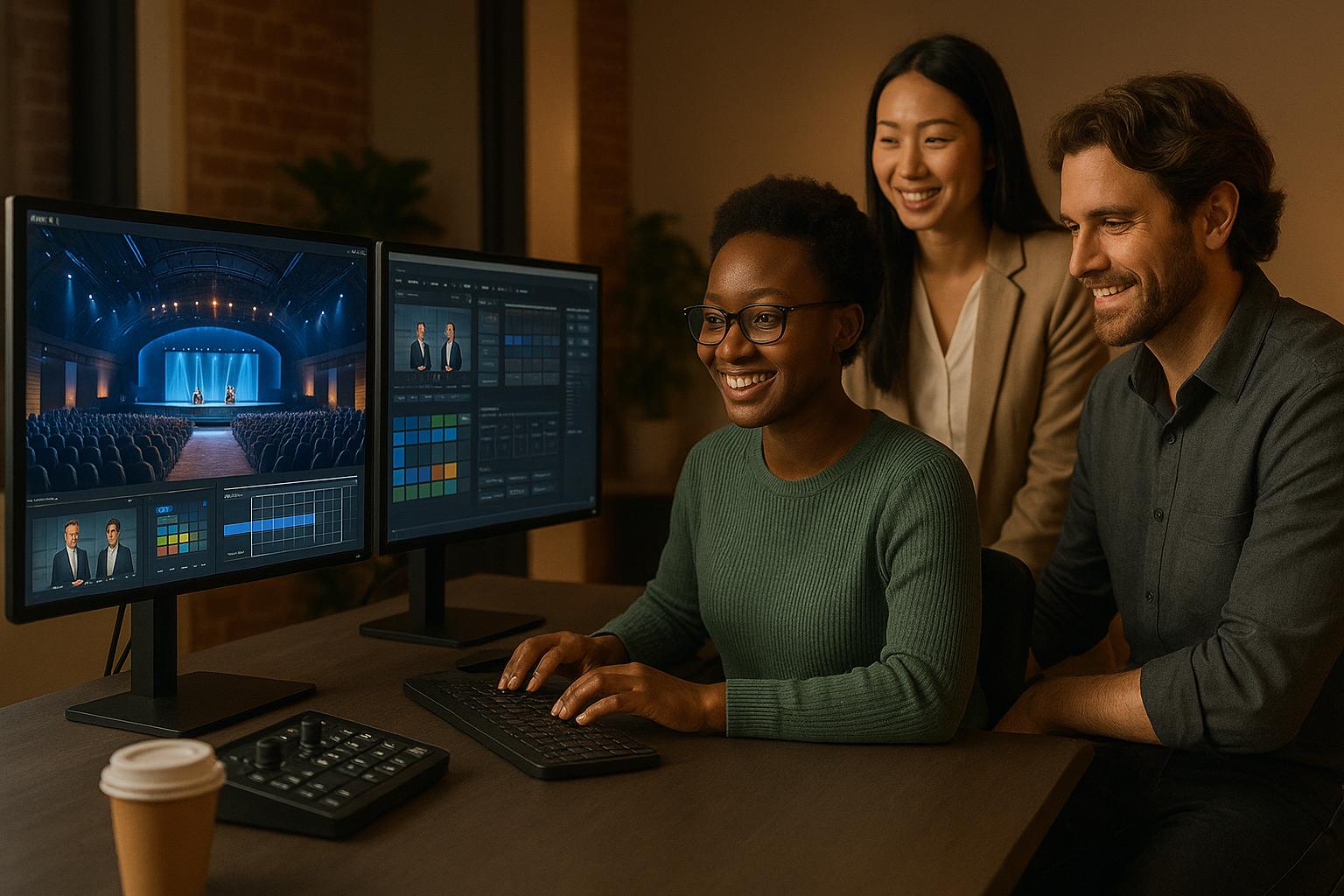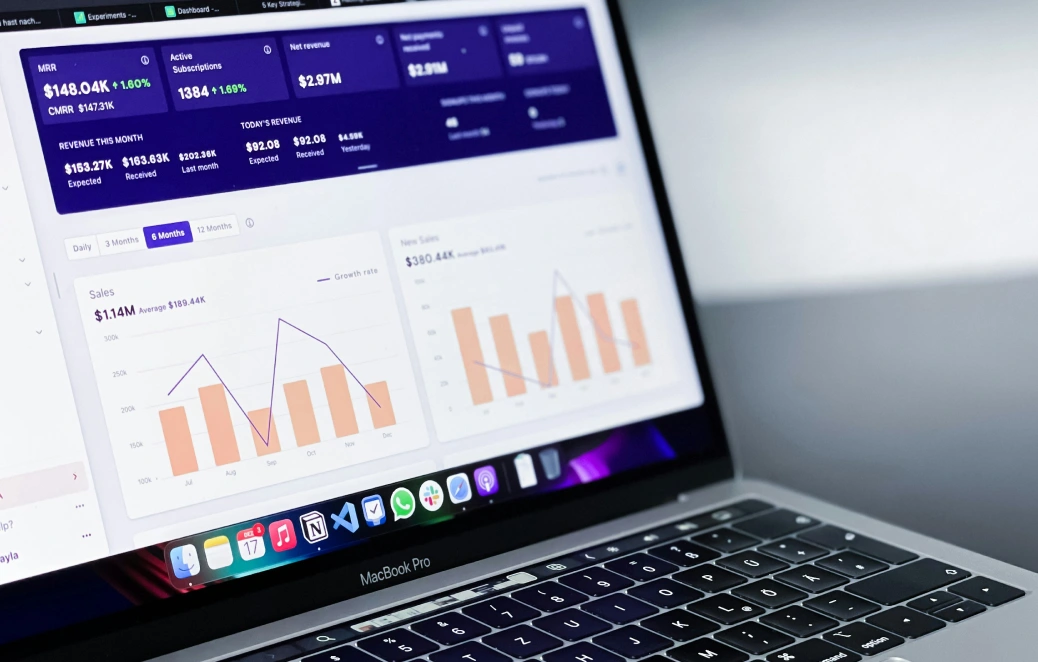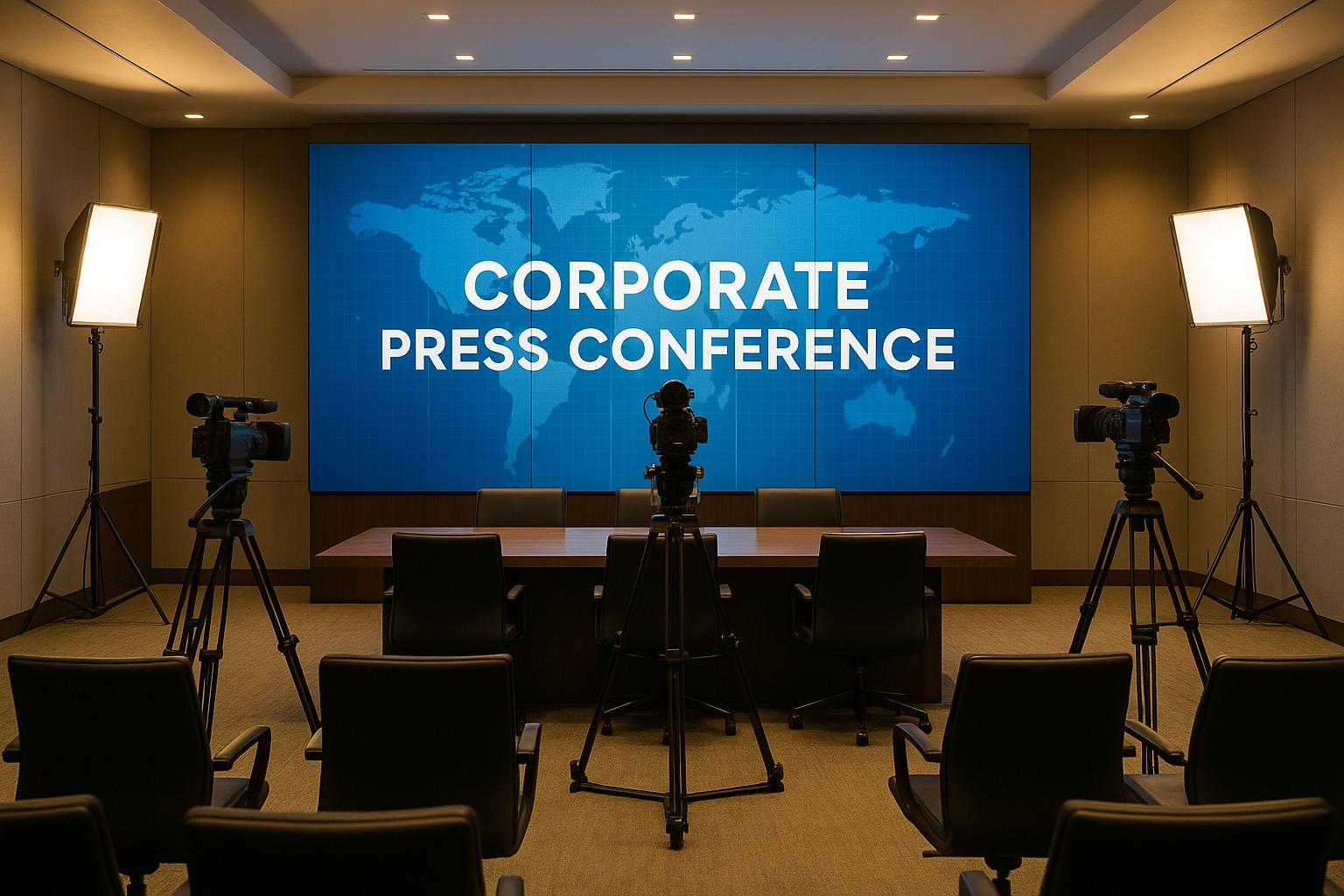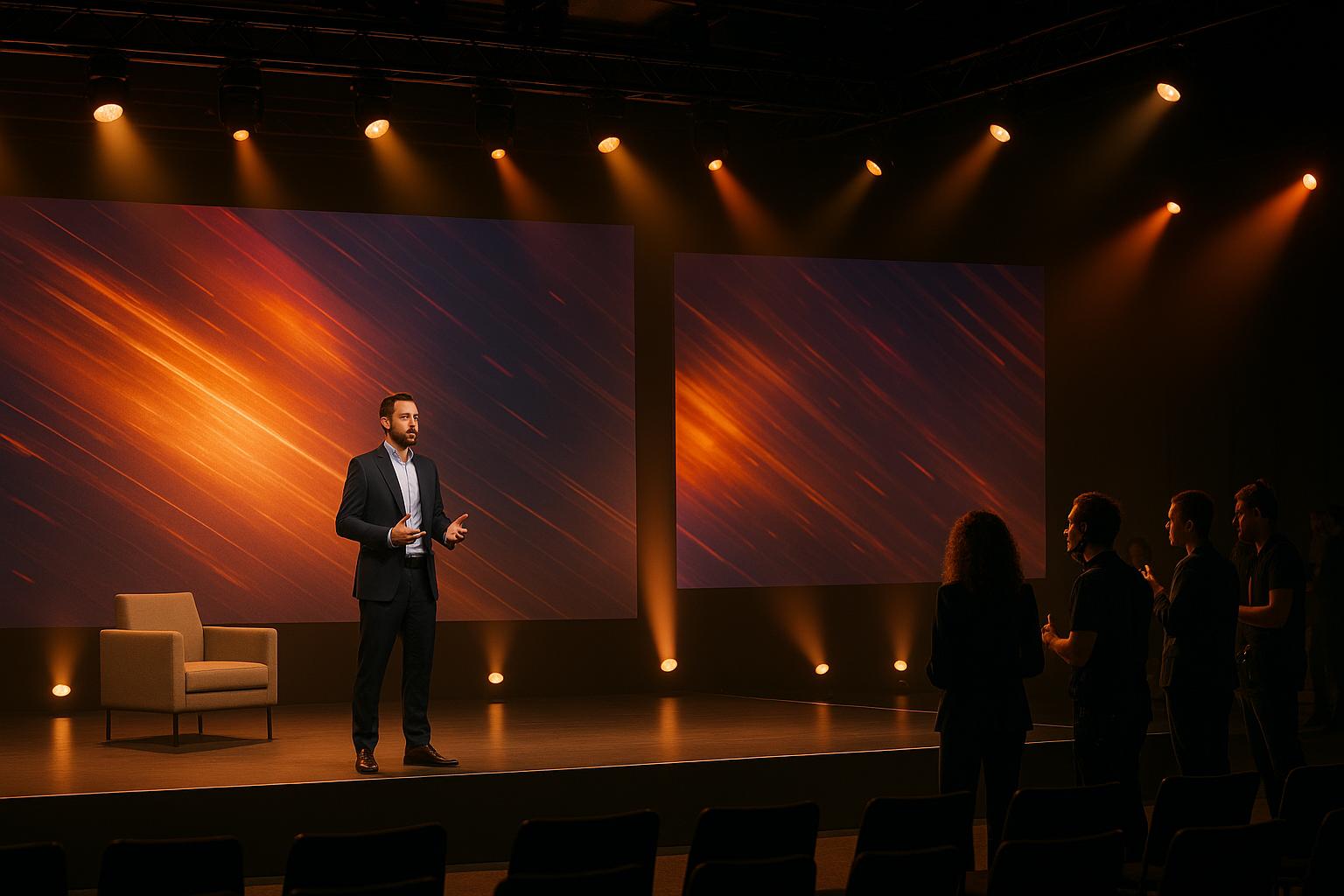Ultimate Guide To Choose A Production Company For A Virtual Broadcast

Chief Executive Officer

When planning a virtual broadcast, selecting the right production company is critical. A poorly executed event can hurt your brand, while a well-run broadcast keeps your audience engaged and delivers results. Here’s what you need to know:
- Key Services to Look For: Multi-camera setups, branded graphics, audience engagement tools, and seamless content integration.
- Technical Expertise: Ensure the company has experience with events of your scale, reliable equipment, and redundancy plans for smooth execution.
- Risk Management: Ask about backup systems, technical support, and contingency plans for unexpected issues.
- Post-Event Support: Highlight videos, analytics, and on-demand content are essential for maximizing impact.
- Vendor Evaluation: Review portfolios, ask for references, and compare proposals to find a partner aligned with your goals.
Choosing a production company isn’t just about technology; it’s about finding a reliable partner who understands your vision and can execute it flawlessly. Use this guide to make an informed decision and create a broadcast that resonates with your audience.
BEHIND THE SCENES Virtual Event Studio CRAZY Tech Setup!
Understanding Virtual Broadcast Requirements
Grasping the ins and outs of virtual broadcasts is crucial when assessing production companies. These events demand a mix of cutting-edge technology, creative expertise, and flawless coordination - things that most organizations aren’t equipped to handle on their own.
What Virtual Broadcasts Include
A virtual broadcast brings together various components to create an engaging online experience. At its core, live streaming serves as the backbone, enhanced by branded graphics and real-time integrations across multiple platforms. Whether your audience tunes in via YouTube, LinkedIn, or a custom event platform, the goal is to deliver a seamless viewing experience.
Graphics integration elevates a standard video feed into a polished, professional production. This includes features like lower thirds to identify speakers, animated transitions, branded overlays, and real-time data visualizations. Picture the sophisticated graphics you’d see on a major news network - that’s the level of quality audiences now expect.
Audience engagement tools ensure viewers stay involved rather than just watching passively. These can include live polls, Q&A sessions, chat moderation, and breakout rooms. Some events even incorporate gamification, virtual networking spaces, or interactive product demos, which often require specialized expertise to pull off effectively.
Multi-camera coordination adds a layer of professionalism and visual variety. Switching between wide shots, close-ups of speakers, audience reactions, or remote participants keeps the broadcast dynamic. Achieving this requires precise lighting, framing, and perfectly synced audio for every angle.
All these elements depend on a strong technical and creative foundation.
Technical and Creative Requirements
A successful virtual broadcast relies on robust audio-visual systems and reliable internet connections. Professional setups often include redundant bandwidth, backup streaming servers, and failover systems that automatically kick in if the primary connection falters.
Real-time rendering capabilities allow for on-the-fly adjustments during the event. Producers can tweak graphics, switch virtual backgrounds, or incorporate audience feedback without disrupting the stream.
Engaging scenic design and clear storytelling are equally essential. This might involve physical sets, LED walls displaying custom visuals, or virtual environments that make it look like speakers are presenting from entirely different locations.
Content integration is another critical piece of the puzzle. Live presentations, pre-recorded videos, sponsor messages, and interactive segments all need to flow seamlessly. Poor timing or awkward transitions can quickly derail the experience.
While technology and creativity set the stage, smooth execution hinges on well-coordinated workflows.
Workflow and Coordination Needs
Planning and preparation are everything. Pre-production meetings, technical rehearsals, and clear communication channels ensure everyone - from directors and camera operators to audio engineers and speakers - is on the same page.
Content management workflows are vital for juggling the constant stream of graphics, videos, and interactive elements. Operators must time everything perfectly while keeping an eye on technical performance and audience engagement.
Post-production efforts often start before the live event wraps up. Teams work to capture highlights for social media, edit versions for on-demand access, and compile analytics reports for stakeholders.
Managing remote participants adds another layer of complexity. Speakers joining from different locations need technical support, backup communication options, and properly coordinated local setups.
Throughout the process, quality control monitoring is a must. Technical teams oversee stream quality, audio levels, and user experience across various devices and platforms, addressing any issues before the audience notices.
These operational elements are key when evaluating a production company. Knowing your event’s needs in advance helps you choose a partner capable of delivering the high-quality experience your audience expects.
How to Evaluate Production Companies
Choosing the right production company for your event involves more than just browsing attractive websites or glossy marketing brochures. It's about digging deeper to assess their actual capabilities, reliability, and the range of services they offer. Here's how you can evaluate potential partners to ensure they meet your event's unique needs.
Checking Technical Skills and Experience
Start by examining their portfolio. Look for evidence of successfully managing events similar in scale and complexity to yours. For instance, a company that excels in hosting small webinars might not have the expertise to handle a 5,000-person virtual conference with multiple breakout sessions and interactive features.
Ask to see recordings of past events. This will give you a firsthand look at their production quality. Pay attention to smooth transitions, consistent audio, and polished graphics. Issues like choppy video, delayed audio, or awkward speaker transitions are red flags.
Industry certifications and awards, such as an Emmy, can also speak volumes about their ability to produce broadcast-quality content. Credentials like these often translate into a more seamless event experience.
Don’t forget to inquire about their equipment and technology. Companies that own their gear often have deeper technical expertise and can respond to issues more quickly. Additionally, review the team’s background. Experienced broadcast engineers, directors, and producers - especially those with a history of working on major corporate events or live TV productions - are indicators of a skilled and capable team.
Once you’ve confirmed their technical expertise, the next step is to evaluate the scope and integration of their services.
Reviewing Available Services
Determine whether the company offers full-service solutions or specializes in specific areas. Full-service providers manage everything from initial planning and speaker coaching to post-event analytics and content repurposing. This comprehensive approach typically leads to better coordination and fewer communication hiccups.
For live streaming, check if they support multi-platform broadcasts, can handle varying internet speeds, and offer real-time quality monitoring. Backup streaming servers and redundant internet connections are essential safeguards against unexpected outages.
Audience engagement tools can vary widely. Some companies stick to basic features like chat and polling, while others provide advanced options like networking platforms, gamification, and interactive breakout rooms. Align these capabilities with your specific engagement objectives to ensure they meet your goals.
Post-event services are often overlooked but are crucial for maximizing your event's impact. Look for providers who can deliver highlight videos, detailed analytics, lead generation data, and on-demand content formatting. These services help measure success and improve future events.
Creative services, such as scenic design and virtual set creation, can elevate your event from ordinary to extraordinary. Whether it’s custom set construction, LED wall integration, or virtual environments, ensure their creative vision aligns with your brand and visual standards.
While service offerings are important, don’t overlook their ability to manage risks effectively.
Backup Plans and Risk Management
A professional production company should have robust redundancy plans. Ask about their failover procedures and contingency plans for critical systems. This ensures they can quickly adapt if something goes wrong.
Technical support is another critical area. Find out how many technicians will be available during your event, whether on-site or remotely. What’s their average response time for resolving issues? Do they offer 24/7 support for events spanning multiple time zones?
Insurance coverage is often underestimated but vital. Ensure the company carries general liability insurance, equipment coverage, and indemnity protection. This shields you from financial risks if technical failures or equipment issues disrupt your event.
Crisis communication protocols are equally important. A reliable production partner should have a clear plan for keeping organizers, speakers, and audiences informed during technical difficulties. They should be able to switch to backup systems seamlessly while maintaining communication.
Even virtual events require planning for external factors like weather or location-specific challenges. If the company is managing on-site elements or remote speakers, they should have strategies for dealing with power outages, internet disruptions, and other unforeseen issues.
Balancing technical expertise, a comprehensive range of services, and strong risk management practices is key to selecting a production company that can deliver a successful virtual broadcast. While companies that excel in all these areas may come with higher upfront costs, they often provide better overall value and peace of mind.
sbb-itb-ae35a94
Questions to Ask Potential Vendors
When selecting a production company, asking thoughtful questions can help you determine whether they truly understand your broadcast goals and have the expertise to deliver a seamless virtual event.
Experience and Capabilities
Start by asking for examples of events they've handled that are similar to yours. This will give you a sense of their ability to meet your specific needs. Dive deeper by asking if they perform presenter pre-interviews, remote production assessments, and virtual rehearsals. These steps are essential for ensuring a polished and engaging broadcast. For instance, a strong vendor typically focuses on narrative impact, visual storytelling, pacing, and audience engagement during these preparations.
It’s also worth exploring the background of their creative team. Find out if their directors, producers, and engineers have experience in broadcast television or large-scale corporate events. This kind of expertise can make a big difference in managing technical challenges and delivering a professional production. Additionally, ask how they handle unexpected technical issues during live events - this insight can reveal their ability to adapt under pressure.
Technical Support and Problem Solving
Beyond their experience, it’s critical to understand how the vendor handles live production challenges. For example, some companies provide comprehensive day-of support, including troubleshooting and problem-solving, so you can focus on creative and editorial elements while they handle the technical execution.
Ask about the staffing and resources they’ll dedicate to your event. How many technicians will be on hand? What’s their typical response time for resolving issues? Will support be available on-site, remotely, or both? These details will help you gauge their readiness to manage your event smoothly.
Contingency planning is another key area to explore. Ask about their backup systems and redundancies for critical parts of the event. A reliable vendor will have robust solutions in place to address unexpected challenges, including detailed plans for logistics, media coordination, and rehearsals.
Finally, inquire about how they communicate during technical difficulties. How will they keep you, your speakers, and your audience informed if something goes wrong? What protocols do they follow to switch to backup systems without disrupting the experience? A vendor’s ability to combine creative expertise with quick problem-solving is essential for a flawless broadcast.
Comparing Vendors and Making Your Decision
Once you've gathered information from potential production companies, the next step is to evaluate your options carefully. This requires organizing the details you've collected and using a structured approach to make your decision.
Building a Vendor Comparison Chart
A comparison chart can help you objectively assess each vendor. Include both technical and business criteria that are critical for your virtual broadcast.
Start with technical capabilities. Note each vendor's experience and expertise in the technical aspects of production.
Then, move on to service offerings. Some companies may be experts in basic streaming, while others provide a full range of services such as scriptwriting, 3D animation, and post-production. Be sure to document what each vendor offers and see how well their services align with your specific needs.
Include a column for pricing structure. Break down their fees, noting whether they charge flat rates or hourly fees, and highlight any additional costs for overtime, scope changes, or technical support.
Finally, assess their communication and reliability. Pay attention to how quickly they respond, their availability, and how they handle technical questions. Their communication during initial discussions often reflects how they’ll perform during your event.
This chart will serve as the foundation for the next step: selecting and interviewing vendors.
Selection Process Steps
Using your comparison chart, narrow your choices to three to five vendors. A smaller shortlist allows you to evaluate each option thoroughly without feeling overwhelmed.
Schedule interviews with your top candidates. Use these discussions to focus on how they would handle your specific project. Ask them to walk you through their process from start to finish, including how they would address potential challenges.
Request detailed proposals that outline their services, timelines, and costs. A strong proposal will include specifics like crew assignments, equipment lists, and contingency plans, rather than vague promises.
Additionally, ask for references from recent clients. Inquire about the vendor’s performance, reliability, and problem-solving abilities. Recent references are especially helpful because they reflect the vendor's current capabilities and team.
Completing the Partnership Agreement
Once you've chosen a vendor, solidify the partnership with a clear agreement. This step ensures that both parties are aligned and sets the stage for a successful collaboration.
Start by clearly defining the services the production company will provide. This might include scriptwriting, graphics creation, technical support, and post-production work.
Discuss the budget in detail. Go beyond just comparing costs - talk about how the vendor plans to deliver the best value for your investment. Ensure the contract includes transparent pricing in USD and outlines what could lead to additional charges.
Include provisions for scope management. Virtual broadcasts often evolve, so establish a process for handling changes. Define how additional work will be priced and approved to avoid misunderstandings or budget overruns.
Add success metrics and objectives to the agreement. Whether it’s technical performance, audience engagement, or content delivery, both parties should be clear on what constitutes success.
Address distribution and promotion capabilities as well. Make sure the vendor can deliver content across various platforms, from mobile devices to large screens, and clarify their role in promoting your broadcast.
Finally, set up communication protocols and project management procedures. Decide how often you’ll receive updates, establish primary points of contact, and outline how decisions will be made during production. Regular check-ins and clear communication channels will help you stay on track and avoid surprises as your event approaches.
Conclusion: Getting the Best Virtual Broadcast Results
Selecting the right production company for your virtual broadcast goes beyond just streaming - it’s about finding a partner who understands your vision and can bring it to life without a hitch.
The production partner you choose plays a pivotal role in your broadcast's success. Each decision at this stage shapes the final outcome. A dependable and skilled production team ensures everything runs smoothly, offering technical expertise, creative solutions, and the confidence that comes from working with professionals who’ve tackled similar challenges. Their ability to communicate effectively and perform under pressure is just as crucial as their technical know-how.
Look for companies that take the time to ask thoughtful questions about your audience, goals, and potential obstacles. These are often the teams that deliver the best results.
When comparing options, balance your technical needs with your budget. Set clear expectations and accountability measures to ensure the production team meets the professional standards your audience expects.
Throughout the process, maintain open communication with your chosen partner. The most successful virtual broadcasts are built on strong collaboration, where your vision aligns seamlessly with expert execution. By staying actively involved and working closely with your production team, you can create a broadcast that truly connects with your audience.
Use the insights from this guide to evaluate your options carefully. Your audience deserves a polished, engaging virtual experience, and the right production company will make that happen.
FAQs
What key technical skills should a production company have for a successful virtual broadcast?
When selecting a production company for your virtual broadcast, it’s crucial to focus on their technical expertise. Look for skills in areas like real-time rendering, camera tracking, and virtual set design. These capabilities allow for a smooth blend of virtual elements with live footage, resulting in a polished and engaging presentation.
It’s also important to find a team with a solid grasp of augmented reality (AR) graphics and how to incorporate them into live broadcasts. AR can add dynamic and visually striking elements to your event, keeping your audience engaged from start to finish. Choosing a company with a proven track record in these areas ensures a professional, high-quality production that aligns with your vision.
How can I make sure a production company is prepared to handle technical issues during a live virtual event?
To prepare for potential technical hiccups during a live virtual event, it's essential to ask the production company about their risk management strategies. Do they have contingency plans for issues like internet disruptions, power outages, or equipment malfunctions? A reliable company should have redundant systems, spare equipment, and a team of skilled technicians who can step in immediately to resolve problems.
You should also ask about their process for real-time troubleshooting and whether they perform thorough pre-event testing to catch potential issues beforehand. A company with a proactive plan and attention to detail can help ensure your event stays on track, even if unexpected challenges arise.
What post-event services should a production company provide to enhance the success of my virtual broadcast?
To make sure your virtual broadcast leaves a strong impression, it's important that the production company offers essential post-event services. These can include expert editing to fine-tune and enhance the recorded material, delivering a polished final version ready for on-demand access or promotional efforts.
They should also provide analytics and performance reports to help you understand audience engagement and pinpoint opportunities for improvement. Some companies go a step further by assisting with content repurposing, like creating bite-sized clips for social media or marketing campaigns, maximizing the reach and impact of your broadcast.
Related Blog Posts









